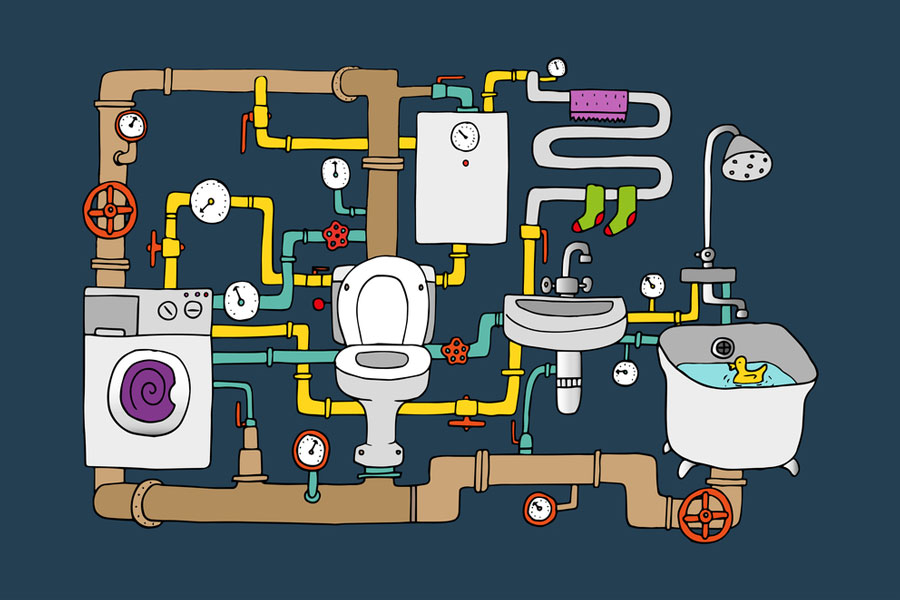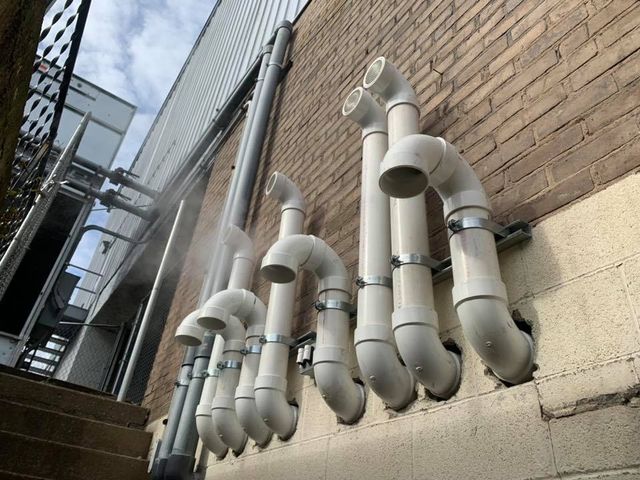What're your concepts about The Inner Workings of Your Home's Plumbing?

Understanding how your home's plumbing system works is necessary for every single property owner. From supplying tidy water for drinking, cooking, and showering to safely eliminating wastewater, a properly maintained plumbing system is important for your family members's wellness and comfort. In this comprehensive overview, we'll explore the elaborate network that comprises your home's pipes and deal pointers on maintenance, upgrades, and taking care of common problems.
Intro
Your home's plumbing system is more than just a network of pipes; it's a complex system that ensures you have accessibility to tidy water and reliable wastewater elimination. Recognizing its components and just how they work together can help you protect against expensive fixings and make certain whatever runs smoothly.
Basic Elements of a Plumbing System
Pipelines and Tubes
At the heart of your plumbing system are the pipelines and tubes that bring water throughout your home. These can be constructed from numerous products such as copper, PVC, or PEX, each with its advantages in terms of longevity and cost-effectiveness.
Components: Sinks, Toilets, Showers, and so on.
Components like sinks, bathrooms, showers, and tubs are where water is made use of in your house. Recognizing just how these components link to the plumbing system helps in identifying issues and preparing upgrades.
Valves and Shut-off Points
Valves regulate the circulation of water in your pipes system. Shut-off shutoffs are vital throughout emergencies or when you need to make repairs, allowing you to separate parts of the system without interfering with water circulation to the whole home.
Supply Of Water System
Main Water Line
The main water line attaches your home to the local water or a personal well. It's where water enters your home and is distributed to various components.
Water Meter and Stress Regulator
The water meter measures your water use, while a stress regulatory authority guarantees that water flows at a secure stress throughout your home's plumbing system, protecting against damages to pipes and components.
Cold Water vs. Warm water Lines
Understanding the difference in between cold water lines, which supply water straight from the major, and hot water lines, which carry warmed water from the water heater, aids in fixing and planning for upgrades.
Drainage System
Drain Water Lines and Traps
Drain pipelines bring wastewater away from sinks, showers, and toilets to the drain or septic system. Catches avoid sewage system gases from entering your home and likewise trap particles that could cause obstructions.
Ventilation Pipelines
Ventilation pipelines permit air into the drain system, preventing suction that might slow down drain and cause traps to vacant. Appropriate ventilation is important for keeping the integrity of your pipes system.
Importance of Appropriate Drainage
Making certain appropriate water drainage prevents back-ups and water damages. Frequently cleansing drains and keeping traps can stop costly repair services and expand the life of your plumbing system.
Water Heater
Types of Water Heaters
Hot water heater can be tankless or traditional tank-style. Tankless heating units warmth water as needed, while tanks keep heated water for instant usage.
Upgrading Your Plumbing System
Reasons for Updating
Updating to water-efficient components or replacing old pipelines can boost water quality, decrease water expenses, and raise the value of your home.
Modern Plumbing Technologies and Their Advantages
Discover modern technologies like smart leak detectors, water-saving bathrooms, and energy-efficient hot water heater that can conserve money and decrease environmental effect.
Price Factors To Consider and ROI
Compute the upfront costs versus long-lasting financial savings when considering plumbing upgrades. Numerous upgrades pay for themselves with minimized energy costs and less repairs.
How Water Heaters Connect to the Plumbing System
Understanding how water heaters link to both the cold water supply and hot water distribution lines assists in identifying problems like inadequate hot water or leakages.
Upkeep Tips for Water Heaters
On a regular basis purging your hot water heater to eliminate sediment, inspecting the temperature setups, and examining for leaks can prolong its life-span and improve energy efficiency.
Common Plumbing Issues
Leaks and Their Reasons
Leakages can happen due to aging pipelines, loose fittings, or high water stress. Dealing with leaks quickly stops water damage and mold growth.
Obstructions and Clogs
Obstructions in drains and bathrooms are typically caused by flushing non-flushable things or an accumulation of grease and hair. Using drain screens and bearing in mind what decreases your drains can prevent obstructions.
Indications of Plumbing Troubles to Expect
Low water pressure, slow-moving drains, foul odors, or unusually high water costs are indicators of prospective plumbing troubles that ought to be addressed without delay.
Pipes Maintenance Tips
Routine Inspections and Checks
Set up annual pipes assessments to catch problems early. Search for signs of leakages, rust, or mineral accumulation in taps and showerheads.
DIY Upkeep Tasks
Easy jobs like cleaning tap aerators, checking for commode leaks utilizing dye tablets, or protecting exposed pipes in cool climates can protect against major pipes problems.
When to Call a Professional Plumbing Technician
Know when a plumbing problem requires expert proficiency. Trying complex repair work without correct knowledge can cause more damage and greater repair work prices.
Tips for Decreasing Water Use
Straightforward practices like taking care of leakages quickly, taking much shorter showers, and running full tons of washing and dishes can save water and reduced your energy costs.
Eco-Friendly Plumbing Options
Think about lasting pipes products like bamboo for flooring, which is durable and environment-friendly, or recycled glass for kitchen counters.
Emergency situation Readiness
Steps to Take During a Plumbing Emergency situation
Know where your shut-off shutoffs lie and how to switch off the water system in case of a ruptured pipeline or major leak.
Significance of Having Emergency Get In Touches With Useful
Maintain call details for neighborhood plumbers or emergency services readily offered for fast feedback during a plumbing crisis.
Environmental Impact and Conservation
Water-Saving Components and Home Appliances
Mounting low-flow taps, showerheads, and commodes can dramatically lower water use without giving up performance.
DIY Emergency Fixes (When Applicable).
Temporary fixes like using duct tape to spot a dripping pipeline or positioning a container under a leaking tap can reduce damage until a specialist plumbing professional gets here.
Verdict.
Comprehending the composition of your home's plumbing system empowers you to keep it successfully, conserving time and money on repair services. By following normal maintenance regimens and remaining notified concerning modern-day pipes innovations, you can ensure your pipes system runs successfully for many years to come.
Understanding Your Home Plumbing System: A Comprehensive Guide
Plumbing System: The Lifeline of Your Home
At its core, the plumbing system is designed to perform two primary functions: bring fresh water into your home and remove wastewater. The system is a network of pipes, fixtures, and other components that transport water and sewage. Residential plumbing systems include potable water supply lines, drain-waste-vent (DWV) systems, and various plumbing fixtures that make water use in daily tasks possible.
Key Components:
Water Supply: This part of your plumbing system brings municipal water into your home, passing through the main water supply line. It s responsible for supplying all water needs, from drinking to bathing.
Drainage System: It carries waste and water away from your home to the sewer or septic system. This system includes all the piping within your home that leads to external sewage or septic systems.
Vent System: An essential yet often overlooked component, the vent system allows sewer gases to escape and lets air into the drainpipes, ensuring water and waste move correctly through the system.
Fixture: More Than Just Taps and Toilets
Plumbing fixtures are the most interactive parts of the plumbing system, including faucets, showers, toilets, and sinks. Each fixture is connected to the plumbing system and plays a role in either the delivery of freshwater or the disposal of waste and wastewater.
Types of Fixtures:
- Faucets and Sinks: Used for washing hands, dishes, and other daily water needs.
- Toilets: Dispose of human waste through the sewage system.
- Bathtubs and Showers: Provide bathing facilities, requiring both hot and cold water supply.
Water Supply: The Source of Life
The water supply system is a critical component, ensuring that potable water is available throughout your home for various uses, including drinking, cooking, and cleaning. This system consists of pipes that distribute water to different parts of the house, controlled by valves to regulate the water flow.
Types of Plumbing: Materials and Methods
Various types of plumbing systems and materials are used in residential settings, each with its advantages and applications. From copper and PVC pipes for water supply to cast iron and ABS for drainage, the choice of materials can impact the longevity and efficiency of your plumbing system.
https://intownplumbingtx.com/articles/home-plumbing-system-guide/

I was shown that report about Exploring Your Homes Plumbing Anatomy from a buddy on another web blog. Appreciated our review? Please quickly share it. Help somebody else locate it. Many thanks for going through it.
Book A Service Call
Comments on “The Layout of Your House's Plumbing System Explained”